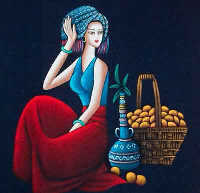
Chinese wax printing is a special Chinese handicraft typical of ethnic characteristics and local styles. As one of the most antique handworks, it is perceived as an important part of China's ancient civilization.
Originating in theQin(221-206BC) andHan (206BC-AD220) dynasties and prevailing in theSui(581-618) andTang dynasties (618-907), wax printing, which been passed down from one generation to the next in China, is a uniquely inspired drawing and dyeing handwork of theMiao ethnic minority. Today, wax printing is mainly distributed among the ethnic minority areas ofGuizhou,Yunnan,SichuanandGuangxiprovinces. In the course of its development, the art acquired its unique folk artistic features and is one of the most characteristic national arts in China.

Called "laran" in Chinese, wax printing is a way of decorating fabric by covering parts of it with a coat of wax and then dyeing it. Beeswax is the main ingredient but other resins can also be used. To make a wax printing, certain areas of the fabric are selected and blocked out by brushing or drawing wax that has been heated in a little pot over the cloth; the cloth is then dyed different colors. The parts covered by wax resist the dye and retain their original hues. This process of waxing and dyeing can be repeated to create more elaborate and colorful designs. After the final dyeing the wax is removed and the fabric is prepared for usage or display. The wax printings can be framed and, if used properly, can make any house or office more unique and inviting.
The raw materials used in wax dyeing are pure cotton fabrics; the usual tools used for applying wax include a piece of copper and brass with bamboo handles. They are made from two small triangular pieces of metal, with their apexes bound to a bamboo holder by a copper wire. It is held like a pen either upright or on a slant in relation to the cloth, which is laid flat on a board. This tool is convenient for drawing straight or slightly curved lines.

Miao and Bouyei minority girlsin China are highly skilled at wax printing. The realistic designs are usually plain, simple or rough in style. The shapes, not confined to the exact detail of nature, are boldly diverse and often exaggerated. This diversity and exaggeration come purely from the imagination, and are breathtakingly charming. The varied designs presented in either geometric shapes or as natural images, which generally stem from human life or legend, and are characterized with a rich folk hue.
The patterns of most wax printings are rooted in social history, totem worship, mythical legends or religious ethnic cultures. For example, Miao wax printings convey the independent idea for beauty and the way of thinking of Miao women, expressing their yearning for happiness, respect and admiration for life, a d worship of ancestors. Such patterns can feature geometric images, animals or plants.










